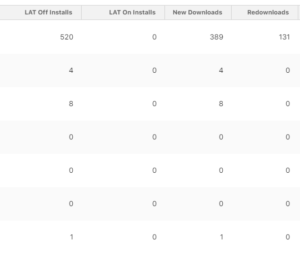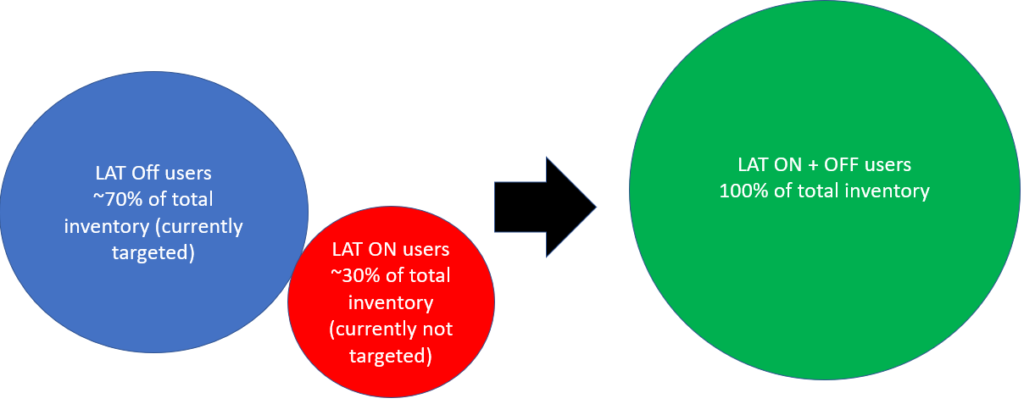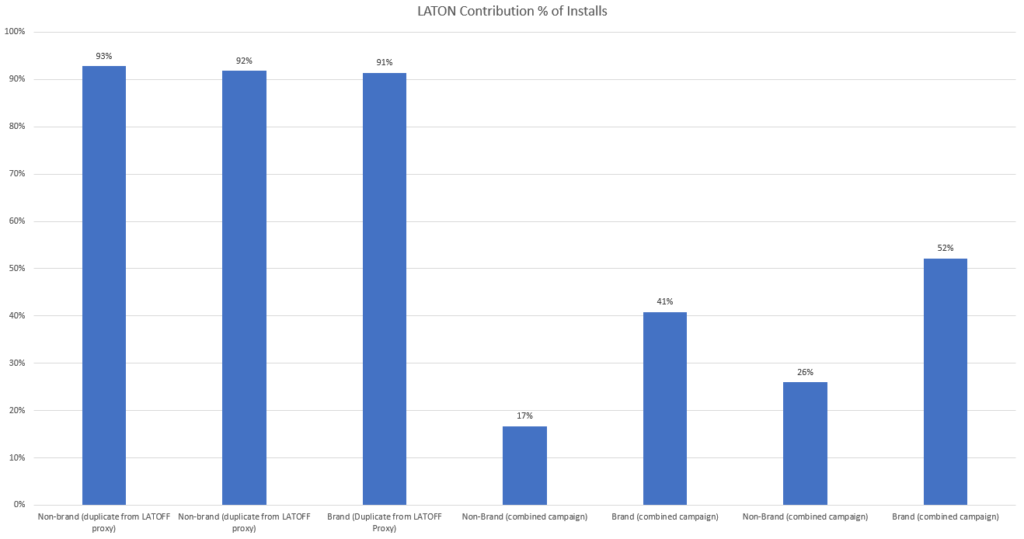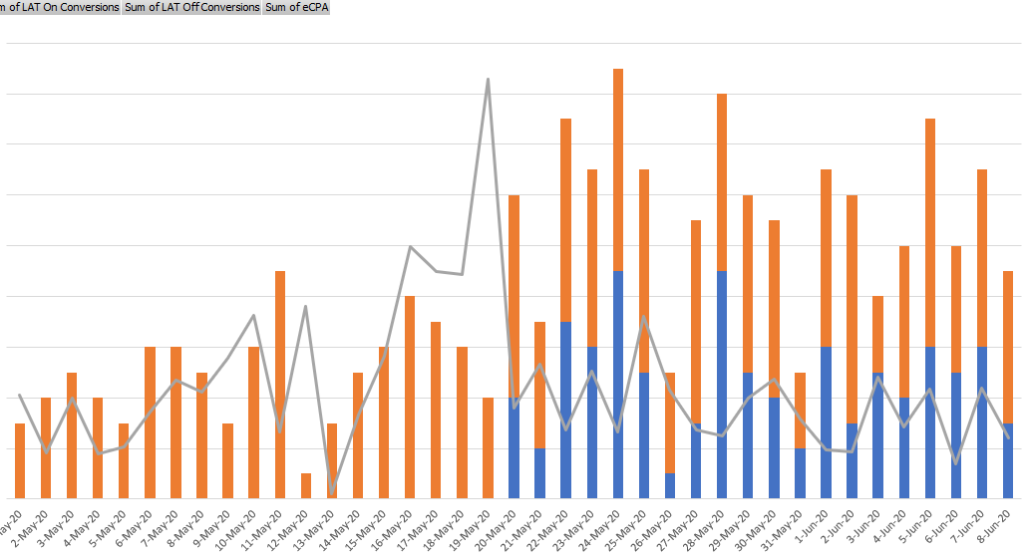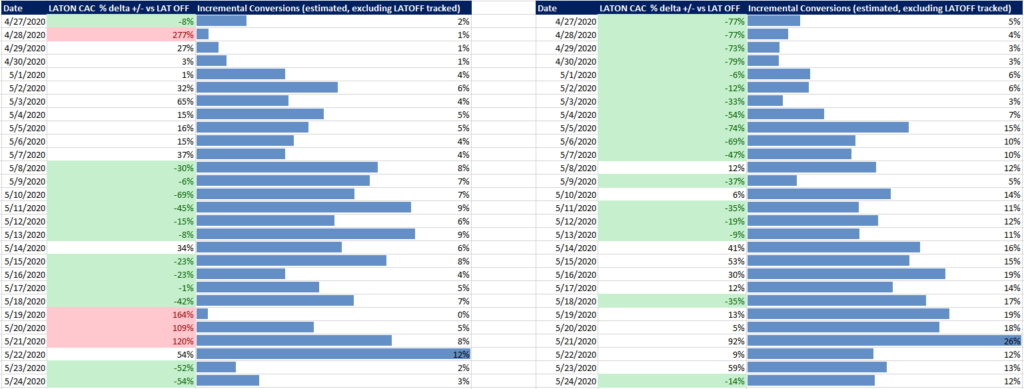Incipia blog
Apple Search Ads LAT ON: A Case Study and Reporting for Optimizing for LAT ON Installs
Ready to get started expanding your campaigns to advertise to Apple Search Ads Limit Ad Tracking (LAT) users?
Bookmark this post and use our reporting template to help you plan your strategic and tactical approach.
Before clicking this link to our LAT ON reporting methodology, we would recommend reading this full post, and we also want to be clear that our reporting methodology is a work in progress subject to change. We stress that our approach to Apple LAT ON estimations (and this post) is likely to evolve as we continue to work through this problem, and advise that you check back often and join us in conversation in Slack communities and through email (email gabe@incipia.co if you have ideas!). We welcome comments from the industry, and would love to work with other Apple Search Ads thought leaders to develop the best approach to this complex problem.
While the challenge is simple to understand, the process can become devilishly detailed depending on whether or not you want to account for redownloads and new users separately. Our advice is to treat new and returning users the same if you can help it, because trying to account for them differently will increase the number of assumptions built into your model, and given the nature of LAT ON, there is no 100% assured way to segment in this manner.
In summary, the lesson learned is that expanding to LAT ON does increase your install volume to a very significant degree, and that you can experience some improvements in CPA as well. Expanding to LAT ON if you are running brand campaigns is a no brainer, and depending on your methodology expanding to performing non-brand keywords can be a big boon for scale and efficiency, too (so long as your methodology is accepted by your reporting stakeholders).
Setting the Stage: What is LAT? How Does LAT ON Differ from LAT OFF?
Again, "LAT" is the abbreviation of Limit Ad Tracking, and refers to the advertising privacy setting in iOS devices that allows users to turn their IDFA (ID for advertising) into a string of zeroes, effectively eliminating tracking for these users after install.
Although MMPs differ in how they handle LAT reporting (Adjust shows a column that indicates the % of a source's users with LAT enabled while AppsFlyer attributes all installs from users with LAT enabled to the organic bucket), all MMPs for Apple Search Ads cannot attribute post-install data on users with LAT enabled, leaving all these events (e.g. signups, purchases, retention events, etc.) to be lumped into the organic source. While fingerprinting can be used to still track users with LAT enabled and claw reporting visibility back from organic, this method does not work for self-attributing networks like Apple Search Ads.
This is produces the primary benefit of LAT for users, and the problem for advertisers, which is that users can neither be targeted with the sophisticated ad serving tools of modern UA, nor can users with LAT enabled be tracked over their in-app lifetime to know how valuable (or not) they (as identified by their IDFA) are. Additionally, while likely more of an edge case in practice, if users enable LAT after downloading an app, all data from the point LAT is enabled moving forward will be attributed to organic, leaving these users' cohort data trial to suddenly drop to 0 and re-allocated to organic.
Thankfully Apple provides reporting on users with LAT ON and LAT OFF for campaigns, ad groups, keywords and even creative sets and search terms. There is also a redownloads and new downloads column, which presents the tempting next effort of segmenting LAT OFF downloads into new downloads and redownloads, and LAT ON along the same lines.
Unfortunately, due to the nature of LAT (i.e. not tracking/targeting users using any data about who they are beyond the keyword they search), there is no possible way to do so, nor is there a way to target only LAT ON users, separately.
Also related to the nature of LAT, don't expect to see LAT ON users in your returning user campaigns/ad groups. So when setting up LAT ON expansions, you only need to worry about new user targets.
When running Apple Search Ads campaigns generally there sometimes will appear redownloads in a new downloads campaign. When running a demographic targeted LAT OFF campaign, this is mostly just a trickle (< 10% of installs), but this can increase however beware when expanding to LAT ON this trickle of redownloads can turn into a significant share of all installs, which can make it challenging to calculate the proper proxy multiplier from LAT OFF to apply to LAT ON if you are using the combined campaign approach.
And depending on keyword you're targeting, you may find a higher or lower degree of redownloads; brand for instance tends to have a much larger share of redownloads vs non-brand.
One of the main benefits supporting that LAT ON expansion is good for business is the ability to acquire more users who can be assumed to be the same (or more) valuable as LAT OFF users, at a discount due to auction dynamics.
The below images shows the step-by-step theoretical impact of the auction dynamics behind why this discount exists.
Important to note is that this is predicated on the presence of a two-tiered auction where a larger subset of all Apple Search Ads advertisers bid on LAT OFF only users and a smaller sub set of Apple Search Ads advertisers bids on all users. If and when the vast majority of advertisers open up bidding to all users, this auction arbitrage opportunity will be nullified.
Additionally, theory never translates 1:1 to the real world, so your experience will likely show different results from the above.
Data Supporting LAT ON Expansion
Just for kicks, what does the non-LAT ON ROI from a campaign running LAT ON users look like?
The answer is pretty bad, especially if you are running a LAT ON Catchall campaign (option #1 below). In one case the CAC of a LAT ON Catchall campaign vs the LAT OFF campaign was over 1,000% more expensive than the LAT OFF campaign.
A similar example of this is the massive discrepancies in downstream, MMP-tracked ROI if you run Google UAC iOS-enabled search campaigns without applying a search blacklist.
How many additional installs can you expect from expanding to LATON?
The answer here depends on several factors:
- Which country you run LAT ON in, and what the local LAT enable-rate of users is. For instance based on our experiences, MMP-provided data and through conversations with industry leaders, users in the main English markets (US, UK, CA, AU, NZ) have LAT enabled rates of ~30-40%
- Whether you are running brand or non-brand (again, we see higher LAT ON contribution margins for brand)
- What your bids are (the lower you bid, the more share of LAT ON users you will likely receive, due to the two-tier auction dynamics explained above)
- Whether or not you are running a LAT ON catchall campaign, or just a LAT Mixed campaign
From the below small sampling of campaigns we see that a LAT ON Catchall campaign (no demographic targeting with lower bids than the LAT OFF primary campaign) can drive a very large share of LAT ON installs, and when running only a single LAT ON mixed campaign (no LAT OFF campaign) installs volume is lower, lower still for brand vs non-brand.
In the below example, opening up to LAT ON produced an average incremental gain of +30% install volume in Canada at initially no impact to CPI (market dynamics pushed CPI higher towards the end of the test).
This third example below, while at low volume was one of the most successful (an international brand campaign) which drove over 50% incremental install volume at as high at a 50% CPA discount.
Great. But will those installs drive efficiency gains too from the phase 1 dynamics?
Depending on your reporting methodology, the conversion rate into downstream events from your LAT OFF installs, and the CPA of your LAT ON installs, the answer may be a yes, no, or maybe so.
In this below example we are followed an option 2 setup, method 2 reporting and made regular optimizations to these two campaigns, in which we saw periods of very positive and very negative CAC vs the concurrent LAT OFF campaign (left, green/red formatting), with generally significant downstream, incremental conversion gains (right column, bar formatting).
In this second example below of an option 1 setup, method 2 reporting for three campaigns, we see that ROAS improves consistently by 23% to 36% (CA non-brand keyword type 1), but not for all campaign types due to low conversion volume.
In this last example of an option 1 setup, method 1 reporting campaign, we see that this brand campaign benefits from a consistent ~20% bump in ROAS.
How to Set up Your LAT ON Expansion Campaign(s)
So how do you expand to LAT ON users?
Setup Option 1 (Recommended): Two Campaigns (LAT ON Catch-All and LAT OFF)
Many advertisers new to LAT ON expansion will likely prefer to duplicate their LAT OFF campaign and remove demographic targeting, effectively creating a catchall campaign and calling this the "LAT ON" campaign. Important to note is that this is not actually a LAT ON campaign, it is just a campaign allowed to serve ads to LAT ON users, which means that LAT OFF installs can still filter into this catchall campaign (especially if you raise bids on this campaign).
The major pro of this option is that it makes for easier management and downstream KPI CVR reporting on LAT OFF proxy conversion rates, and also by splitting the "LAT ON" segment into a separate campaign, which enables filtering the LAT ON catchall campaign from your reports to get a true tracked ROAS/CAC report.
The con of this option is that it creates risk of impression-splitting/cannibalization (depending on bids, TTR and CVR LAT OFF installs may flow into your LAT ON catchall and vice versa) which produces a headache for reporting and campaign management.
Setup Option 2: One Campaign (LAT ON Mixed)
The alternative option is to simply remove demographic targeting from your campaign and allow LAT ON users to filter in. This addresses the challenge of impression-splitting, but can complicate reporting efforts as the LAT ON spend from this campaign cannot be easily filtered out of ROAS reports (spend and CPA applies to all installs, and cannot be filtered for LAT ON vs LAT OFF).
2 Methodologies for Reporting on LAT ON Users
Here is our first draft of a reporting methodology for estimating Apple Search Ads LAT ON performance. We would love to hear your feedback! Email gabe@incipia.co.
Method 1 (Treat New Downloads & Redownloads the Same)
The first methodology is the easier but less customized, and treats new and redownloaders the same, simply applying an average downstream conversion rate from your LAT OFF installs to your MMP downstream conversion data (remember, you know that the tracked conversions are possible only to come from LAT OFF installs).
You can get by with this method if you see a very low % of redownloads filtering into your campaigns or if you don't need to estimate separately for user install status.
The step-by-step process here entails:
- Download data from Apple Search Ads
- Download downstream conversion data from your MMP
- Estimate the cohorted KPI from the MMP data and your Apple Search Ads LAT OFF installs (either using your LAT OFF campaign for option 1, or the LAT Mixed campaign from option 2)
- Apply this KPI conversion rate to your LAT ON installs
- Sum the MMP data with your estimated performance to get total KPI performance
Method 2 (Estimate for New Users & Redownloads Separately)
If you see a high % of redownloads or you want to estimate for new and redownloads differently given differences in ARPU/user value, you may need to implement method 2, which is more complex and much more assumptive. Before proceeding here, it's important to recall that there is no 100% accurate way to segment LAT ON installs into new and redownloads, or the same for LAT OFF installs.
When using this method you'll want to set up a redownload LATOFF proxy campaign to ensure you get an accurate proxy rate for returning users.
The step-by-step process here entails:
- Download data from Apple Search Ads
- Download downstream conversion data from your MMP
- Establish the % of new downloads vs redownloads, and use this to get an assumption of LAT ON new/redownloaders and LAT OFF new/redownloaders
- Estimate the cohorted KPI performance from your MMP data and your Apple Search Ads LAT OFF installs, segmenting conversions from new users separately from returning user. Currently we prefer to use a proxy conversion rate from a campaign purely targeting returning users as the redownloader conversion rate (again these are pure returning users, so it eliminates one assumption). Be sure to use the LAT OFF new/redownloads install assumption to calculate your downstream KPI conversion rate
- Apply the downstream conversion rate to the approprate LAT ON new/redownloader install split
- Sum the MMP data with your estimated performance across new and redownloaders with your tracked MMP performance to get total KPI performance
Recap of the Problems Facing LAT ON Reporting
- You cannot target only LAT ON users, leading to unavoidable impression splitting.
- You cannot segment LAT ON and OFF installs into new downloads vs redownloads, leading to difficulties in estimating downstream conversions from LAT ON users (making setup option 1, LATON catchall more appealing), as well as applying these proxy conversion rates to LAT ON installs.
- Unless accounted for in organic reporting, LAT ON estimations will lead to double-counting of users in the organic bucket who are actually acquired through ASA but whose data trails are placed in "organic" by MMPs.
Once more, here is our first draft of a reporting methodology for estimating Apple Search Ads LAT ON performance. Email any feedback to gabe@incipia.co.
We hope this post and our first draft of a reporting framework were helpful and we look forward to hearing your ideas of how to estimate LAT ON performance!
Stay tuned for future posts which will also include details on topics such as Google's newly untrackable, expanded UAC iOS search inventory. Google's expanded iOS search inventory also poses a related problem in that this traffic is not tracked by MMPs (while GDN/YouTube and Android search traffic is), however conversions from iOS search UAC campaigns are estimated using Google's probabilistic machine learning models to provide conversion counts/rates/value/ROI in the Google Ads front end.
Cheers!
Categories
Tags:
- A/B testing
- adjust
- advertising
- adwords
- agile
- analytics
- android development
- app analytics
- app annie
- app development
- app marketing
- app promotion
- app review
- app store
- app store algorithm update
- app store optimization
- app store search ads
- appboy
- apple
- apple search ads
- appsee
- appsflyer
- apptamin
- apptweak
- aso
- aso tools
- attribution
- client management
- coming soon
- design
- development
- facebook ads
- firebase
- google play
- google play algorithm update
- google play aso
- google play console
- google play optimization
- google play store
- google play store aso
- google play store optimization
- google uac
- google universal campaigns
- idfa
- ios
- ios 11
- ios 11 aso
- ios 14
- ios development
- iot
- itunes connect
- limit ad tracking
- ltv
- mobiel marketing
- mobile action
- mobile analytics
- mobile marketing
- monetization
- mvp
- play store
- promoted iap
- promoted in app purchases
- push notifications
- SDKs
- search ads
- SEO
- skadnetwork
- splitmetrics
- startups
- swift
- tiktok
- uac
- universal app campaigns
- universal campaigns
- user retention
- ux
- ux design


